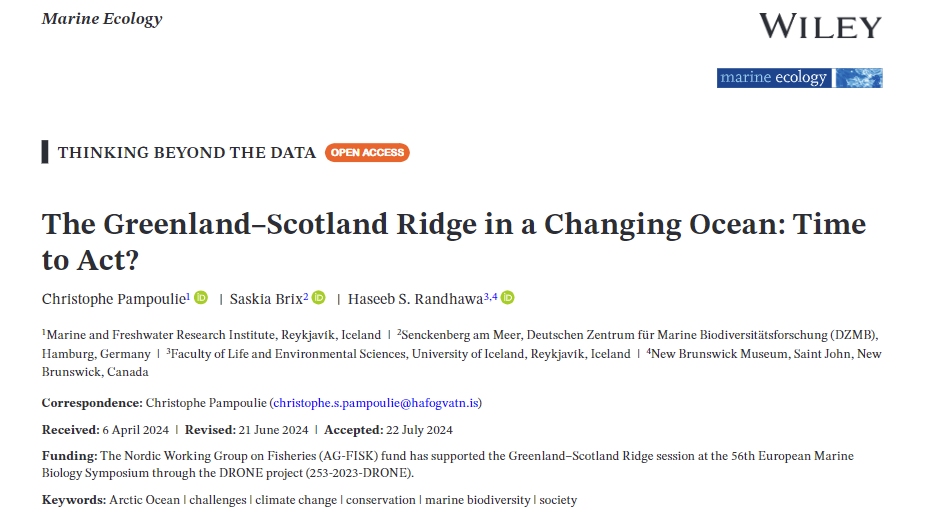Authors: Christophe Pampoulie, Saskia Brix and Haseeb S. Randhawa
BIODICE is pleased to announce a new publication in Marine Ecology. The Greenland–Scotland Ridge in a Changing Ocean: Time to Act?
ABSTRACT
The Greenland–Scotland Ridge is a submarine mountain that rises up to 500 m below the sea surface and extends from the east coast of Greenland to the continental shelf of Iceland and across the Faroe Islands to Scotland. The ridge not only separates deeper ocean basins on either side, that is, the North Atlantic and Arctic oceans, but also forms a geomorphological barrier between the cold arctic water masses of the Nordic Seas and the comparably contrastingly warmer water of the North Atlantic Ocean. It is therefore situated at a strategic geographical position in relation to the effect of climate change in the Arctic region.Both the Arctic and the Atlantic subpolar ecosystems are facing each other at the ridge, creating oceanic fronts in the Denmark Strait and in the Iceland–Faroe ridge alike. This ridge in the subarctic area forms the southern boundary of the North Atlantic Gateway to the Arctic Ocean, affecting exchanges of oceanic currents and of marine organisms between the two main ecosystems in the Nordic polar region. For example, the appearance of natural invasive species such as the Atlantic mackerel in this region mainly occurred along the ridge, with arrival through the Scotland–Faroe Islands mount with subsequent waves of colonization which eventually reached the southern tip of Greenland. With the increasing impacts of climate change, such natural colonization through the ridge is likely to happen more frequently and affect regional ecosystems. Yet, the human resources and the economy of the local nations on the ridge are rather limited compared to neighboring countries. With a total of less than half a million people inhabiting the area and a total ocean surface of circa 3 million km 2 of continental shelf, Greenland, Iceland, the Faroe Islands, and Scotland will face critical challenges in the coming years with respect to biodiversity conservation and sustainable management of marine resources. Here is a summary of what we know, what we might expect, and an opening to potential discussions for the future of research in this region. The main objective of this paper is calling attention to much needed additional research effort on the marine environment around the Greenland–Scotland Ridge, instead of presenting a comprehensive overview of research in this area.
Conclusion
The specificities of the Greenland–Scotland Ridge and the relatively limited human population size and support to research pose a set of unique challenges to generating knowledge on the diversity along the ridge and the potential changes which will affect the region in the future. While the European Commission is attempting to promote the conservation of biodiversity by 2030 and protect 30% of its ocean, associated member states such as Iceland and the Faroe Islands, together with other states with ties to the Greenland–Scotland Ridge, need to combine their effort to secure well-developed research monitoring of this unique region which entails so many different and fragile ecosystems. There is an urgent need to support the mapping and monitoring of biodiversity and the development of a collaborative framework which will facilitate research programs toward a better knowledge and conservation of this unique environment, together with the states managing these areas daily. The emergency is even more evident when considering the explosion of invasive species in the region, facilitated both by human transport and favorable settlement conditions. The lack of information on biodiversity, on functional processes,and many other factors, hinder our ability to properly protect the oceans in the region, and to assess their resilience toward invasive species and climate change effects. There is an urgent need to promote and prioritize training and education programs in many aspects of marine biology and associated conservation and management themes in the region, and to develop a strong framework to support research and governance. Scientists from every research theme are already gathering and trying to pro-mote education, research, and governance in Iceland through the BIODICE network (https://biodice.is/), and we believe that the manifesto developed by BIODICE members could be used as an initial international effort to improve and promote these three pillars along the Greenland–Scotland Ridge. The studies performed over the last two decades, demonstrated the uniqueness and richness of the Greenland–Scotland Ridge which de-serves more attention and probably the status of a specific and unique ecoregion.
